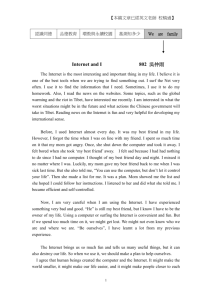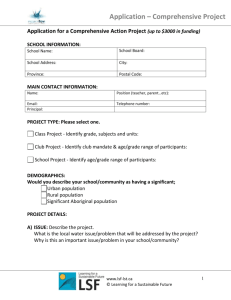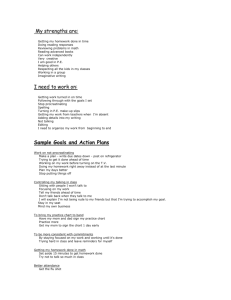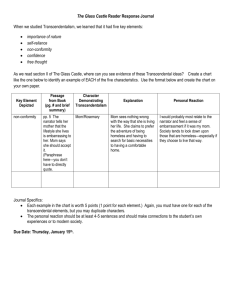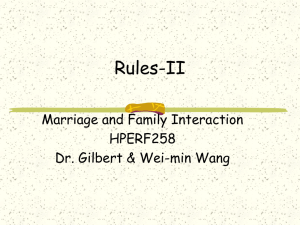Y1T3-6-copy - Functional Family Therapy
advertisement
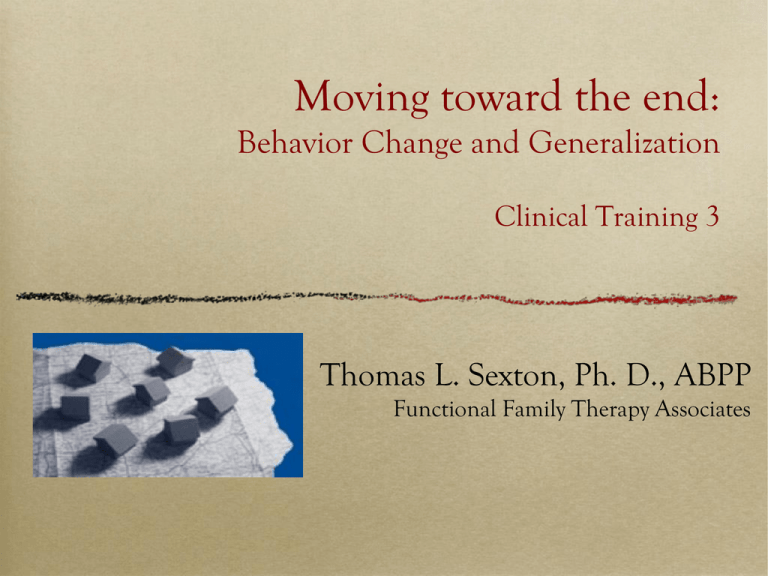
Moving toward the end: Behavior Change and Generalization Clinical Training 3 Thomas L. Sexton, Ph. D., ABPP Functional Family Therapy Associates Goals 1. 2. 3. 4. Matching….. Generalization phase CFS in Clinical Decision making and….. What does it take? A therapist that…… • Looks through a “lens” • Follows a Model……follow the “map” • Creates and implements a “unique case plan” for each family • Use “in the room” experiences to promote change (change mechanisms) • Creatively Adapt..... • Matching to the client • adapting next response to” • • • match client/context add what was not understood/missed Access change....did it work? What does successful FFT require Delivers FFT with Adherence & competency 35.0% •38%* reduction in 30.0% felony crime 25.0% •50%* reduction in 20.0% violent crime 15.0% •$10.67 return for each $1 invested 10.0% •$2100 per 5.0% family cost to implement 0.0% 6 month Adherent 12 months Non-Adherent 18 months Control •Process Focus •what phase am I in? •what are the goals of the phase? •what do I need to assess? •how do I need to intervene •to accomplish the goal •how do I “match to…..” •what do I need to know about…... Therapist Reality “process issues” Change Process Expert Family Reality “alliance/outcome issues” Life Expert An example: Lilly • 14 years old • Referred by juvenile justice system • Pulled a knife on her mother • Marijuana • Expelled from school • Runaway Ecosystemic System Peer/school/community/extended family Clinical Symptoms/Behaviors The Multisystemic Focus of Functional Family Therapy Family Relational System (Sexton, 2010) Ecosystemic System Peer/school/community/extended family Ecosystemic System Peer/school/community/extended family Family changes (joining John’s fmaily) Court system involvement School Struggles (Sexton, 2010) Peer Group Pressure Invovement Ecosystemic System Peer/school/community/extended family Youth Defiance Ecosystemic System Drug Problems family Peer/school/community/extended Depression Violent Behavior Clinical Symptoms/Behaviors Family Relational Pattern (Sexton, 2010) Ecosystemic System Peer/school/community/extended family MOM Lilly -responds defiantly -gets worried -asks (indirectly) MOM Lilly -responds defiantly MOM -jokes, makes fun -tries to get her to “do it for me” -hear it as “she doesn’t care” -gets scared Lilly Obviously irritated -blows off Mom MOM -gets angry -lectures -withdraws Lilly -responds defiantly Lilly -Esclates defiant response -exhibits additional When it is a serious even MOM -esclates control When it is a serious even When it is a serious even MOM -gives a consequence (sever and non specific….takes away Lilly -Esclates defiant response- Problem “definition Problem “definition I have done everything I could I can’t take it because -she is unwilling to work with me -she might have MH problems (depression) -her defiance is the problem -the solution is to “control” I have done nothing wrong… what I did was a mistake and wont’ happen again -the problem is you won’t leave me alone -you took everything from me and there is no reason to try Emotional Reactions (negativity) -anger -hurt -fear of loss of mom Emotional Reactions Anger Hurt Fear of loss of control Behaviors -her role in the problem sequence Behaviors Her role in the problem sequence Adolescent Dad/father figure Mom/mother figure Relatedness Assessment 3 Mom 4 Biological Father Peers Dad 3 2 ? Adol 3 1 1 3 Reframing • • Identify the Behavior(s) (from problem definition) • (mom): Lilly’s defiance is….. • (lilly): Mom’s controlling is….. Acknowledge the importance of each to the person (link their struggle with something important to them) • Reframe Lilly’ defiance is…. Strong willedness Fear of changes Protection of herself Fear at losing Mom Mom’s controlling is… Fear of losing her daughter Protecting her Struggling with her own perceived inadequacies MOM Problem “definition I have done nothing wrong… what I did was a mistake and wont’ happen again -the problem is you won’t leave me alone -you took everything from me and there is no reason to try Emotional Reactions (negativity) -anger -hurt -fear of loss of mom Behaviors -her role in the problem sequence Lilly Problem “definition I have done everything I could I can’t take it because -she is unwilling to work with me -she might have MH problems (depression) -her defiance is the problem -the solution is to “control” Emotional Reactions Anger Hurt Fear of loss of control Behaviors Her role in the problem sequence MOM Organizing/Relational Problem “definition I have done nothing wrong… what I did was a mistake and wont’ happen again -the problem is you won’t leave me alone • everything from me and there is no reason to try -you took Lilly Theme Problem “definition I have done everything I could I can’t take it because -she is unwilling to work with me -she might have MH problems (depression) -her defiance is the problem -the solution is to “control” Explaining the problem in relational Terms • • • • Involves one Emotionalevery Reactions (negativity) Identifies the struggle in descriptive way -anger -hurt Emotional Reactions Identifies the noble intention -fear of loss of mom Anger Identifies the challenge of each Hurt Behaviors -her role in the problem sequence • • Fear of loss of control Them…..“given all that has gone with youBehaviors Her role in the problem sequence gwo….both have come a point where your afraid losing each other….That is hard to see given the behavior…..but behind that is this fear….. Mom….when you are controlling…..really trying to protect your daughter….(maybe not protect way…maybe other ways to protect….but that is the motivation… • Lilly….. • Dealing with life being turned upside down…..struggling with the changes…and having a hard time finding her way in that…. • Defiance….is kind wird and strange way of dealing but…..it does protect her….and it does help hold in some whay to her mom…(and she of course do that different…and, not smart way…) but, is fear of loving you….. Discussion focused on: -drug use -defiance Targets of FFT Behavior Change Parenting -monitoring and supervising Communication -direct and concrete Parent communication Adolescent Conflict Management Where they use: Work out problems…our focus is on their process of doing so Problem Solving Behavior Change Targets 1. 2. 3. Is it Relevant? • What would feel to the family like success • What make a “difference” Is it Obtainable? • Can they do it • Will it derail therapy because it is to hard now Does it “fit” them • Relational functions • Organizing them • Lilly BC 1 • Lilly BC 2 Generalization Phase Generalization Phase Based Treatment Goals: Assessment Late Intervention Generalization Outcomes •Increase behavioral competency of all/family •Consistent performance of competency in “real” problem situation 1.Generalize 2. Maintain 3. Support Shifting Focus for the Therapist • focus of therapy moves from inside the family to the “interface” between the family and those systems that surround it. • It requires a shift in direction for the therapist in regard to clinical assessment and intervention. • respond to the “events” in the family with a primary goal of helping them become ultimately self-sufficient and empowered in their interaction with the surrounding context. • Shift attention away from helping the family solve immediate problems to a discussion about the role of peer, school, and extended family and community interactions as they relate to the family’s ability to continue reducing the probability of future problems. Ecosystemic System Peer/school/community/extended family Clinical Symptoms/Behaviors The Multisystemic Focus of Functional Family Therapy Family Relational System (Sexton, 2010) Ecosystemic System Peer/school/community/extended family Why the Generalization phase families take two “steps” when making changes that are lasting: 1. Families change the relational interactions and adopt alliance-based skills in their daily interactions. 2. Families bring this same attitude and skill set to other naturally occurring issues that confront the family. • In this step, the successful family becomes consistent over time and learns to handle the emotional discouragement of “relapses.” Logic of Generalization • small changes can have a multisystemic effect • These changes often don’t happen naturally • Specific strategies for generalizing new skills, maintaining change, and supporting those changes with the aid of informal and formal community support systems helps create the necessary system change for long term success. • Reduces: • Revolving door of treatment • Relapse • Future positive changes Avoiding the Revolving Door Syndrome The generalization phase is intended to avoid the familiar phenomenon of the “revolving door” syndrome • Each time a family receives services they learn to depend on that organization or person as a “needed resource.” • What they don’t rely on is their indigenous environment of community, extended family, and friends as a source of natural, reliable, and effective longterm interdependence. Avoiding the Revolving Door Syndrome • When caught in the revolving door syndrome, the family is inadvertently robbed of the opportunities to learn to access appropriate support systems. • They don’t build new skills or adapt those gained in earlier phases of therapy, • and they feel little sense of efficacy or confidence in their ability to manage problems independently. • “Give a man a fish and you feed him for a day; teach him to fish and he feeds himself for life.” • “learn to dig for the bait” so that they can have the resources necessary to be self-sufficient in managing the normal challenges of family life. Generalizing Change Behavior Change Built a “competency” to reduce a risk pattern -communication/problem solving/ etc. Going out Primary Target With friends Homework New area Move competency to a new “content” area Move competency to a new “content” area Area/content focused on: -homework, going out with peers, etc. Relationship New area With sibling Time with New area boyfriend Supporting Change Discussion focused on: How to maintain, support, and generalize new climate, alliance, behavior changes Parent Adolescent Extended Family -monitoring and supervising Community/School -direct and concrete communication Area to support changes, add to changes, and places to generalize and extend change Medical Evaluation Psyc Intervention Support Change…resources in community • Families are multisystemic • • • Context will impact ability to support change in the long run Examples: • Parenting class • Individual therapy • Rent assistance • Special school program to help with academic issues Goal: • Have the FAMILY do it….you help direct them • Becoming self-sufficient in using relevant/necessary community resources to help • Using behavior change competencies to deal with the world around them Types of Social Support • Instrumental support (i.e., financial assistance, help with transportation, and parenting assistance) • Emotional support (i.e., empathy, and caring) • Informational support (i.e., help finding the best prices on food, need-based school assistance, or places to get rent and utility assistance). Maintaining Change • • Change process is a up and down experience • Often the down feels as if it is a failure • Goal is to reframe it as a “normal” experience in the change process • The goal….despite the current failure/discouragement to begin the behavior changes again Build confidence/efficacy in their ability to maintain changes….by: • Attribute change to the family • Responding to events they bring in by focusing on relapse prevention Relapse Prevention Successful relapse prevention requires that the therapist take the initiative and direct a discussion that helps to: • Identify high-risk situations. • The discussion should include an analysis of the cues, initiating situations, family conflicts, and patterns of high-risk situations that may undermine the family’s ability to continue with their established changes. Relapse Prevention • Learn alternate ways to respond. • The behavior change strageties they learned • These include identifying ways to: • cope with the negative emotions that arise around these situations, both for individual family members and the family as a whole; • determining ways to deal with interpersonal conflict by applying conflict management principles; and • discovering strategies to cope with social pressure that may result from both proximal and distal support systems. Outcome of Generalization Phase When successful the family: • attributes the change to their effort • is realistic about future struggles • has a plan for how to continue to apply what they have learned to new situations • continue to maintain a within-family alliance and a view of the family based on the organizing theme developed early in therapy. What is enough change? • • When do you end? • What does the say? • What specifically to look at? What gets in the way of ending? • What are your barriers? What are you looking for in the families? • Keep it up • What they need is to find a way to continue the changes they made in therapy despite new problems, the return of old issues, or other risk factors that may get in the way. • This most likely to occur if they know: • where to apply skills, what to bring to discussions (family focus and alliance-based perspective), and • how to continue with the “organizing theme” and direction built in the engagement/motivation and behavior change phases. What are you looking for in the families? • Handle more and different problems • From the family’s perspective, new problems have the tendency to look different. • The more skills that the family needs to employ, the more the chance of success goes down. • Instead of getting endless new lists of skills expand their existing skills to new problems in a way that seems manageable. • They will be most successful if they can apply the small steps of behavior change to an increasingly wider range of issues in daily life. What are you looking for in the families? • Be consistent • There will be times and situations where despite their best efforts, things will be a struggle. • They will be most successful in overcoming these situations if the family focus and behavioral skills are attempted and maintained, regardless of their total success, in situations through time. • By this means, they would overcome the natural discouragement of the ups and downs of change. • One of the most difficult parts of keeping things up are the competing “pulls” clients feels from the world around them What are you looking for in the families? • Adapt and adjust when things come up • It is not uncommon to see the specific change strategies used in FFT evolve as the family uses them. • Families tend to come up with unique family-based, alliance-based solutions that include social skills that fit into the protective factors category. What are you looking for in the families? • Address other bigger issues • Families continue to face risk factors • Address those proactively • • • • Peers School & other community issues Legal requirements Extended family challenges What are you looking for in the families? • Be realistic • Holding the realistic belief that positive change is possible and they do have the ability to succeed is important. • The belief needs to be realistic, not one that sets them up for failure by being too positive. • If the belief includes knowing that things will happen again, that it won’t be fun, but, with effort, there is an alternative, which creates the motivation to initiate new behaviors and put effort into persisting at them.


